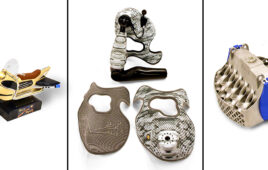Imagine camouflage that renders a subject almost invisible; prosthetic limbs that look and feel like real appendages; smartphone battery power that’s embedded throughout the thin fabric of your clothing; windows that direct light to different parts of the room throughout the day. All of these ideas and much more may be possible with a new age of material science that is now unfolding. Researchers at the South Dakota School of Mines & Technology are learning to manipulate the basic properties of innovative materials to enable revolutionary new products.
“We’re really trying to enhance voxel-level engineering,” says Travis Walker, Ph.D., assistant professor of chemical and biological engineering at South Dakota Mines.
So, what’s a voxel? In photography, the sharpness of an image depends on the number of pixels per inch. More pixels in an image yields more vivid detail.
Move into three dimensions and resolution is not determined by pixels, but voxels, which improves the resolution in 3D printing technology. Today, researchers are working to manipulate single voxel sizes that are smaller than the diameter of a human hair. This effort should deliver very fine and detailed 3D printed parts.

Travis Walker, Ph.D., holds an example of a 3D printed item made with two different materials. He and Katrina Donovan, Ph.D., say this object is a large-scale example of the kind of 3D printed materials now possible at scales smaller than a human hair.
The next evolution in 3D printing may involve the ability to change the properties of a material, voxel by voxel. Just as many different colored pixels make up a vivid photograph, many different types of voxels can make a unique material.
“A large part of my research group is investigating novel materials through controlling the presence of fillers inside additive manufacturing on the voxel level,” says Walker.
As engineers gain the ability to change the makeup of individual pieces of the puzzle, they can construct complex materials with unique properties that have never been seen before.
“We study the fundamental physics on the voxel level. Once we can control the properties of each voxel, we can make meta materials, such as gradient materials, that can advance a number of materials that you can find today,” says Walker.
Walker specializes in the study of fluid mechanics. This work includes an effort to understand complex fluids, soft solids, miscible fluid interactions, and biological systems. Everyone has a basic understanding for how water flows, but thicker fluids like ketchup or paint can exhibit different properties. Walker notes that these thicker fluids, “can be a hindrance when trying to get ketchup out of a glass bottle, or it can be a benefit when spreading paint on a vertical wall. These everyday examples illustrate that complex fluids can be difficult to process, yet when exploited, their complexity can also be useful.”
Part of Walker’s research, which is funded in part by an NSF CAREER Grant, involves the use of tiny disks that can be inserted into each voxel and then moved into a unique orientation using magnetic fields. This work could have a range of applications including more efficient antennas for better wi-fi that enables the internet of things.
Significant challenges are ahead in these fields of research. “We’ve been making composite materials like fiberglass for over a century but controlling things on the voxel level is harder,” says Walker. “The ability to do 3D printing exists, and the ability to insert different particles into each voxel exists. Now, we need the right collaborators who have a need for this kind of engineering application.”
The effort to overcome the challenges is worthy, as research on the physics that happens at these tiny scales could have broad implications from new electronics to advances in medicine, pharmaceuticals, and energy production. “When you attempt to engineer materials on the sub-micron level — how is the organization happening; how do things transport thorough the microstructure — the physics are the same across many different materials,” says Walker.
South Dakota School of Mines & Technology
www.sdsmt.edu
Filed Under: Make Parts Fast




